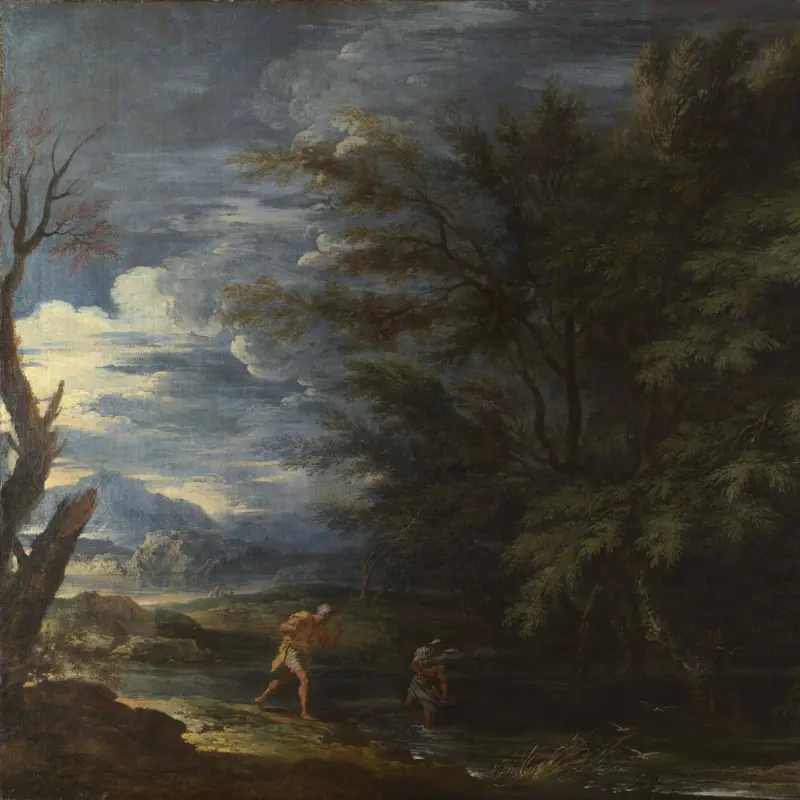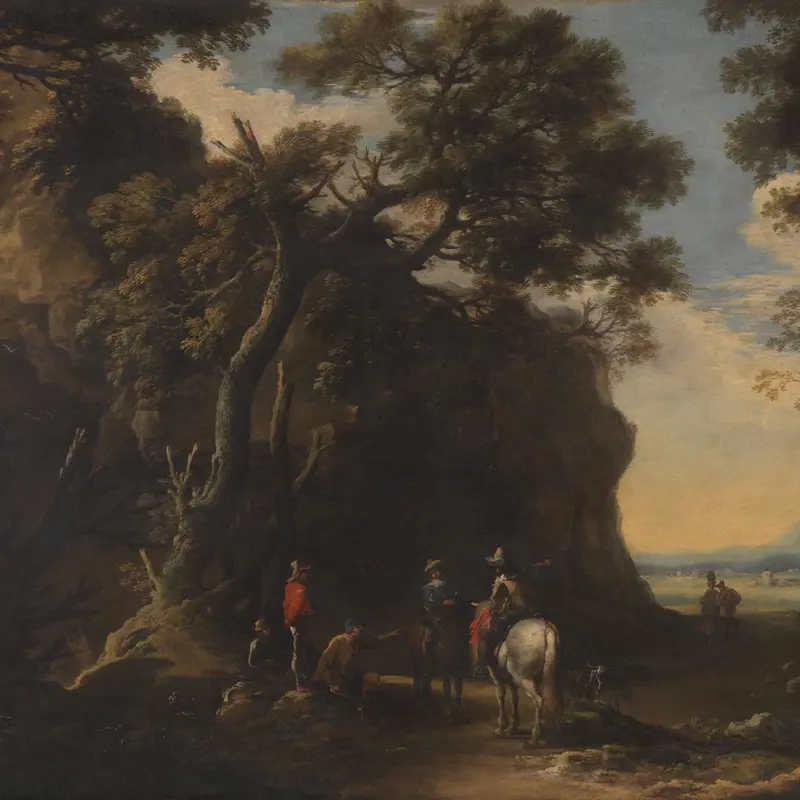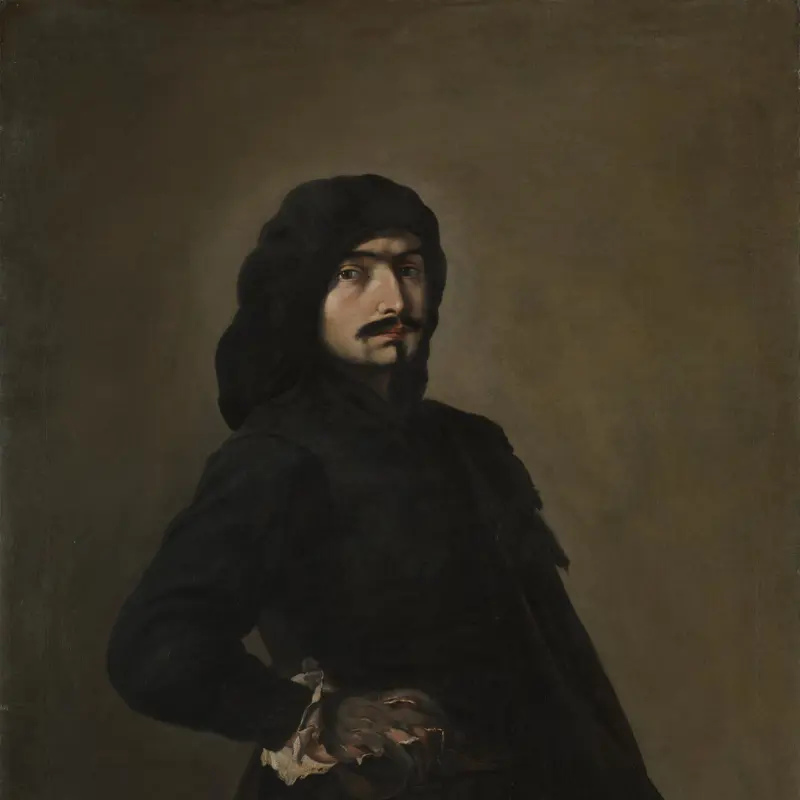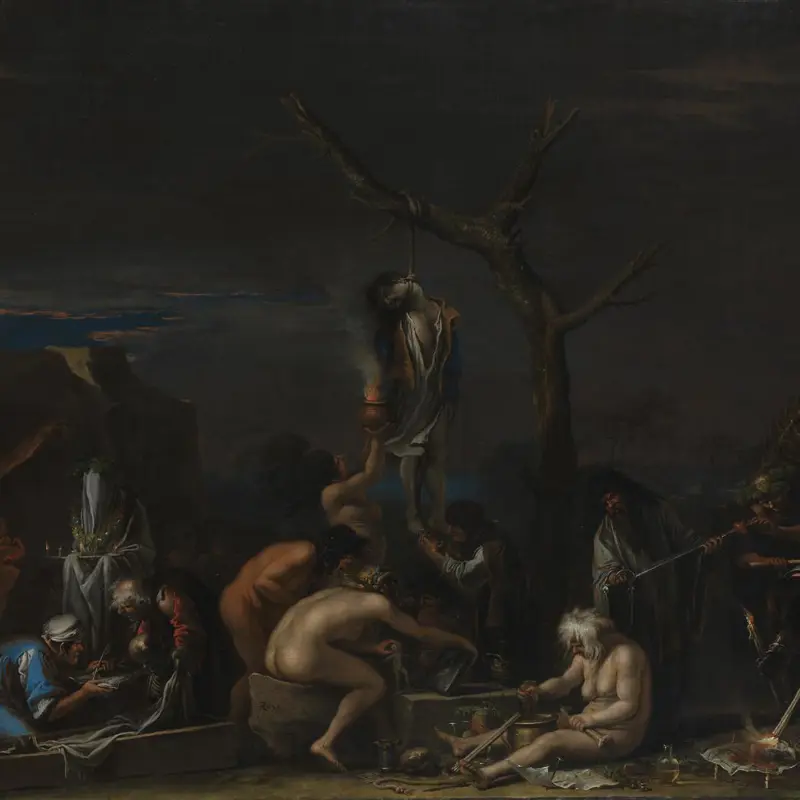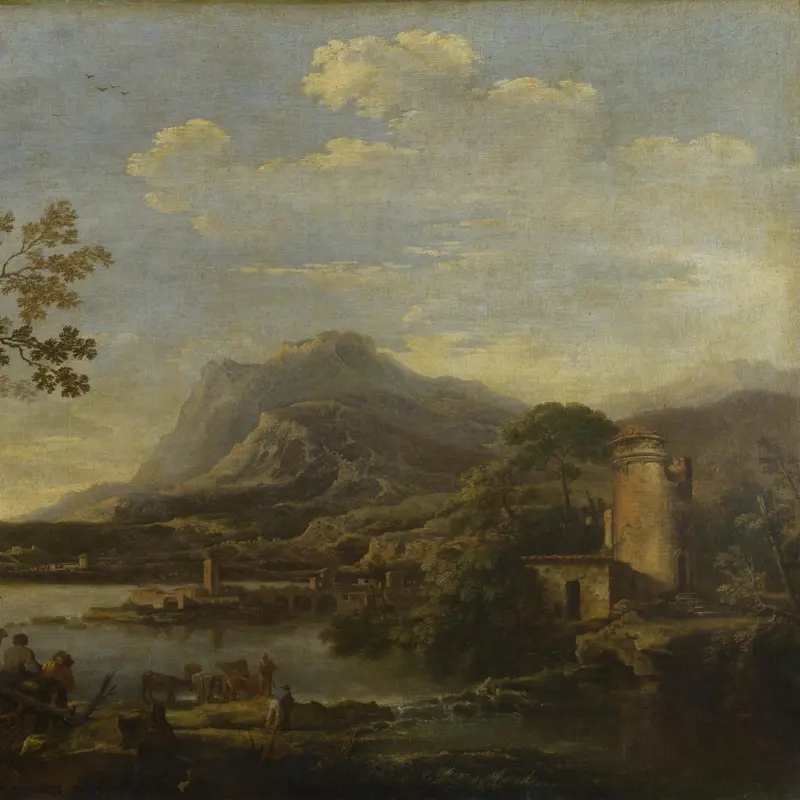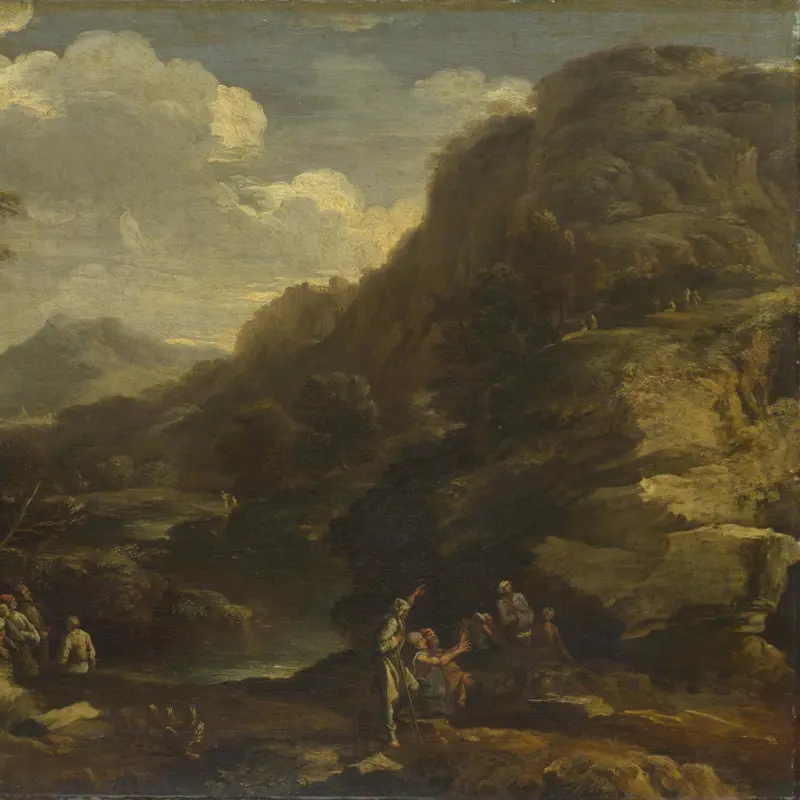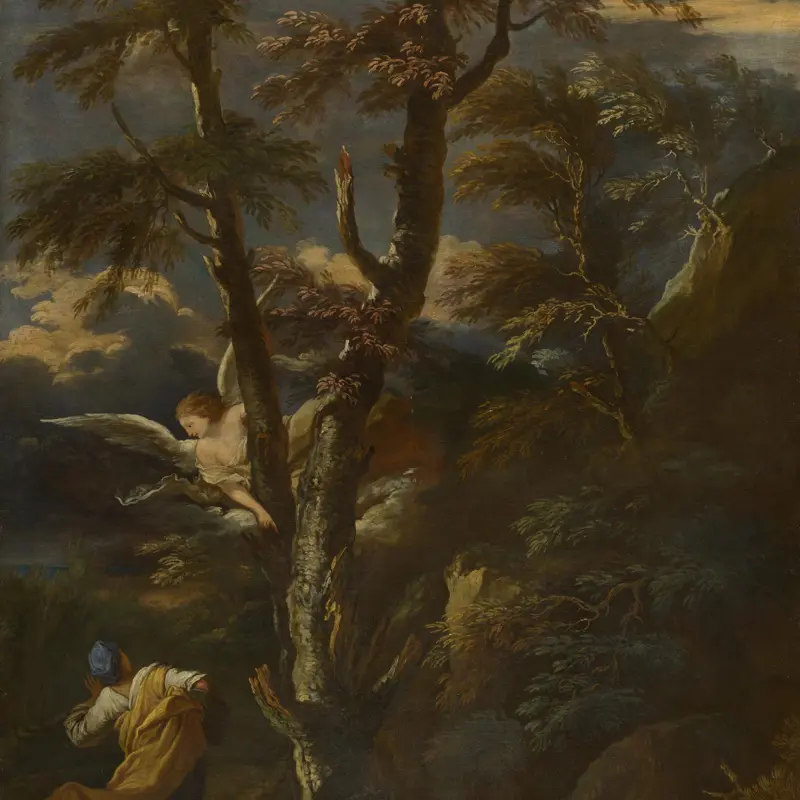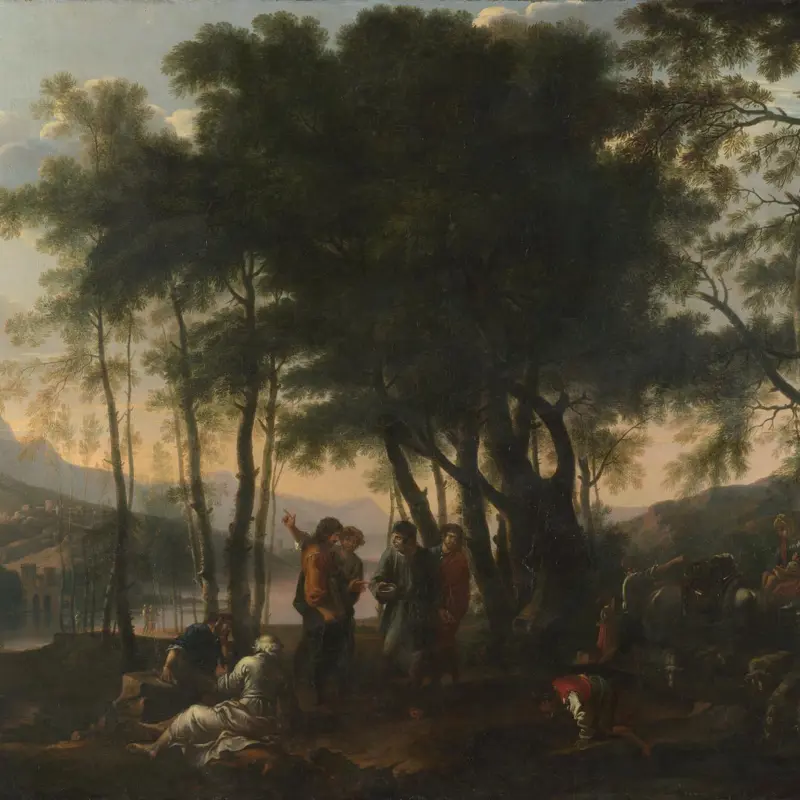Salvator Rosa, 'Philosophy', about 1645
About the work
Overview
A scowling man wearing a scholar’s cap and brown gown appears before us. His drapery, wrapped tightly around him, has the smooth, solid look of a sculpted Roman bust. Half of his face is in shadow and the cold lighting emphasises his long, narrow nose, unkempt hair, unshaven face and furrowed brow.
The man thrusts a tablet bearing a Latin inscription towards us – translated, it reads: ‘Keep silent, unless your speech is better than silence.’ The phrase is taken from Stobaeus’s Anthologia, a fifth-century collection of extracts from Greek authors. There has been much debate over the sitter’s identity, but recent scholarship has shown that the figure was originally painted as a personification of philosophy.
Rosa wished to be recognised as a learned painter of philosophical subjects. He produced this work during the early 1640s for Filippo Niccolini, who belonged to the circle of educated men Rosa befriended during his stay in Florence.
Key facts
Details
- Full title
- Philosophy
- Artist
- Salvator Rosa
- Artist dates
- 1615 - 1673
- Date made
- about 1645
- Medium and support
- oil on canvas
- Dimensions
- 116.3 × 94 cm
- Acquisition credit
- Presented by the 6th Marquis of Lansdowne in memory of his father, 1933
- Inventory number
- NG4680
- Location
- Room 32
- Collection
- Main Collection
- Frame
- 18th-century Roman Frame
Provenance
Additional information
Text extracted from the ‘Provenance’ section of the catalogue entry in Michael Levey, ‘National Gallery Catalogues: The Seventeenth and Eighteenth Century Italian Schools’, London 1986; for further information, see the full catalogue entry.
Exhibition history
-
2010Salvator Rosa (1615 - 1673): Bandits, Wilderness and MagicDulwich Picture Gallery15 September 2010 - 28 November 2010Kimbell Art Museum12 December 2010 - 27 March 2011
Bibliography
-
1677F. Bocchi and G. Cinelli, Le bellezze della città di Fiorenza, dove a pieno di pittvra di scvltvra di sacri templi di palazzi, i piu notabili artifizj, e piu preziosi si contengono, Florence 1677
-
1838G. Yates and Son, Catalogue of Paintings, Belonging to the Rev. John Sanford; Collected in Italy, from 1815 to 1837: Entrusted to G. Yates and Son, to be Partially Disposed of by Private Contract, at 209, Regent Street, London, 1838
-
1854G.F. Waagen, Treasures of Art in Great Britain: Being and Account of the Chief Collections of Paintings, Drawings, Sculptures, Illuminated Mss. […], vol. 2, trans. E. Eastlake, London 1854
-
1897G.E. Ambrose, Catalogue of the Collection of Pictures belonging to the Marquess of Lansdowne, London 1897
-
1934National Gallery, National Gallery and Tate Gallery Directors' Reports, 1933, London 1934
-
1955B. Nicolson, 'The Sanford Collection at Corsham', The Burlington Magazine, XCVII/628, 1955, pp. 207-14
-
1963L. Salerno, Salvator Rosa, Milan 1963
-
1971M. Levey, The Seventeenth and Eighteenth Century Italian Schools, London 1971
-
1973M. Kitson et al., Salvator Rosa (exh. cat. Hayward Gallery, 17 October - 23 December 1973), London 1973
-
1974H. Langdon, Salvator Rosa: His Ideas and His Development as an Artist, Phd Thesis, Courtauld Institute of Art 1974
-
1974H. Langdon, 'Salvator Rosa in Florence, 1640-1649', Apollo, C/151, 1974, pp. 190-7
-
1974F.B. Salvadori, 'Le esposizioni d'arte a Firenze dal 1674 al 1767', Mitteilungen des Kunsthistorischen Institutes in Florenz, XVIII/1, 1974, pp. 1-166
-
1975L. Salerno, L'opera completa di Salvator Rosa, Milan 1975
-
1978W.W. Roworth, Pictor Succensor: A Study of Salvator Rosa as Satirist, Cynic and Painter, New York 1978
-
1981U. Meroni, 'Salvator Rosa: Autoritratti e ritratti di amici', Prospettiva, XXV, 1981, pp. 65-70
-
1983M. Helston, Spanish and Later Italian Paintings, London 1983
-
1986Levey, Michael, National Gallery Catalogues: The Seventeenth and Eighteenth Century Italian Schools, London 1986
-
1986O. Ferrari, 'L'Iconografia dei filosofi antichi nella pittura del sec. XVII in Italia', Storia dell'arte, LVII, 1986, pp. 103-81
-
1988W.W. Roworth, 'The Consolations of Friendship: Salvator Rosa's Self Portrait for Giovanni Battista Ricciardi', Metropolitan Museum Journal, XXIII, 1988, pp. 103-24
-
1989W.W. Roworth, 'Salvator Rosa's Self-Portraits: Some Problems of Identity and Meaning', The Seventeenth Century, IV/2, 1989, pp. 117-48
-
1990A. Sumner, 'The Clerical Connoisseur', Antique Collector, 1990, pp. 124-30
-
1992P. Bjurström, 'Filosofernas skog: En tecknad skiss av Salvator Rosa', Årsbok för Statens Konstmur, XXXVIII, 1992, pp. 47-53
-
1994E. Leuschner, 'The Pythagorean Inscription on Rosa's London "Self-Portrait"', Journal of the Warburg and Courtauld Institutes, LVII, 1994, pp. 278-83
-
1995J. Scott, Salvator Rosa: His Life and Times, New Haven 1995
-
1998K. Patz, 'Sub Rosa: Verschwiegene Beredsamkeit im Londoner Selbstporträt von Salvator Rosa', in C. Göttler and U. Müller Hofstedes (eds), Diletto e Maraviglia: Ausdruck und Wirkung in der Kunst von der Renaissance bis zum Barock, Emsdetten 1998, pp. 60-3
-
2001
C. Baker and T. Henry, The National Gallery: Complete Illustrated Catalogue, London 2001
-
2003J.R. Snyder, 'Sincerity in Seventeenth-Century Italy', Rinascimento, XLIII, 2003, pp. 265-86
-
2007W. Regel and H. Köhler, …Hoch gerühmt, fast vergessen, neu gesehen: Der italienische Maler und Poet Salvator Rosa, Würzburg 2007
-
2007E. Fumagalli (ed.), Filosofico umore, e, maravigliosa speditezza: Pittura napoletana del Seicento dalle collezioni medicee (exh. cat. Uffizi, 7 June 2007 - 6 January 2008), Florence 2007
-
2008S. Cassani, Salvator Rosa: Tra mito e magia (exh. cat. Museo di Capodimonte, 18 April - 29 June 2008), Naples 2008
About this record
If you know more about this work or have spotted an error, please contact us. Please note that exhibition histories are listed from 2009 onwards. Bibliographies may not be complete; more comprehensive information is available in the National Gallery Library.

